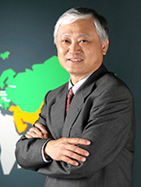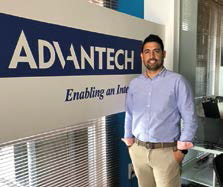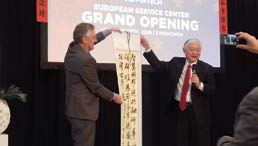3You are the Associate Vice President of Embedded IoT Europe at Advantech since early 2019. What would you like to achieve with Advantech? What are your goals?
My goal is to double sales in Europe over the next five years, something that can only be achieved by working with new partners and expanding our team. However, it is especially difficult to achieve the latter in a market characterized by high demand for qualified workers and this has not changed with Covid. Therefore, measures aimed at increasing efficiency are increasingly relevant to achieving this balance.
We are the world number one in sales, volume and range of products. However, we are not yet the leader in Europe and we are not perceived as a benchmark company in all the vertical markets in which we are present. I would like to change this. Our goal is to become the absolute number one in Europe in the embedded market, but we also want to enter other value chains in order to offer added value to our customers. This means that we want to be the leader in the embedded IoT (Internet of Things) market. With our help, customers will be able to move their businesses into the digital future, all enabled by the software and hardware we supply. This will be a big challenge as most of our clients are slowly preparing to implement full digitization in their companies and establish corresponding digitized processes.
What sets Advantech apart from its competitors? What makes Advantech better or different than its competitors in IoT/IIoT?
As the market leader, Advantech's Embedded-IoT group not only offers the widest range of embedded products, solutions and in-house design services. Our integrated solutions for IoT include everything from sensors (nodes) to distributed computing devices, gateways, and even WISE-PaaS or Microsoft Azure IoT cloud platforms. With more than 25 years of local presence and more than 550 employees in Europe, Advantech provides local consulting and project sales, design and development services, as well as pre- and post-sales technical support, among many other things. We serve our clients in each country, in their own language and in the same time zone. We are stronger and have a broader footprint than our competitors, and much of our IoT middleware is now developed and supported by our development center in Germany.
Furthermore, as a former classic hardware manufacturer, we have focused on understanding the complexity of solutions, especially those related to software, technologies and cloud deployment, all with the aim of delivering added value.
This is why Advantech has invested in its own open source IoT platform for many years and we are increasingly translating this experience into customer projects. We also help clients get their products to market faster through platforms prepared for specific solutions. We can offer our customers functional building blocks made up of hardware and software that help create a combined solution.
IoT-AI (AIoT), that is, IoT and artificial intelligence (AI). This includes off-the-shelf platforms such as gateways, embedded box PCs (or distributed computing devices), and VPU modules belonging to the Vega product line.
Together with the appropriate software modules, they take care of the remote management of devices and sensors. Now it is possible to have functions such as updating, debugging and remote control, as well as the management of storage, transmission, security and data protection, and connectivity with the cloud (Azure, AWS, etc.). For this we have established our own server infrastructure in Munich in order to apply the European security guidelines. We also have a specialized department in Munich that deals exclusively with this security and continuously creates new solutions together with our customers.
How realistic is the union of IoT and AI in AIoT?
The two technologies can be used independently of each other. However, their future union is more than realistic and ultimately inevitable since they cannot evolve completely independently of each other. IoT is capable of collecting large amounts of data and bringing this data together for analysis in a harmonious way. This is critical to AI processes. AI can only add value if it makes the right decisions quickly and effectively under the right circumstances. The only way to create valuable AI is to use large amounts of real data. The great advantage offered by an IoT architecture with distributed computing infrastructure is that the algorithms can be deployed throughout its devices. This allows you to optimize the entire system in terms of latency and bandwidth, providing the best of both worlds. That is, access to large amounts of data directly and the option to simultaneously reduce overheads and dependency on low-latency cloud services. The new connectivity standards, such as WiFi6 or 5G, are of great interest in this regard.
To this end, Advantech combines processing power, connectivity, and the necessary sensors to create an AI platform. All of this implemented on the WISE PaaS cloud platform in conjunction with a Microsoft AI plug-in or our Intel or Nvidia based Vega modules. The AI packages from different technological partners offer a great capacity for processing and analyzing the data supplied by Advantech systems and sending them to the cloud in an extremely efficient and fast way. During the last years this approach has been focused mainly on the hardware but this has changed. At present the integration of the software in the IoT platform is more important. Questions like these need to be answered: How to download the software application on the platform? How can this data be processed efficiently? Ultimately, the information must end up in the customer's ERP system or business processes. That is the next big challenge.
Is there already an initial example? In which sector do you expect the most applications to emerge?
The market for combined IoT and AI solutions has just been born. We expect it to develop significantly within two to three years.
Examples already exist today, as can be seen in the use of automatic passport control at many airports. In this case the data is captured by cameras and then transmitted to a central server via a distributed computing device and/or a gateway, where it is automatically evaluated by software and returned to the distributed device on the machine with the instruction corresponding action. In the future we will see this fusion of IoT and AI devices in many other areas. Its typical applications, determined by the Covid pandemic, are self-service applications in the retail markets and digital signage for indoor and outdoor applications. I think there will also be additional growth in the areas of security, automotive and smart homes, as well as in the medical sector, especially healthcare. In all these areas, data protection must be taken into account, especially for applications with recognition of people in public areas. Here potential conflicts of interest arise that need to be resolved. If IoT and AI technologies are merged, much greater transformation power is obtained.
There are also applications that are very data intensive and are not necessarily optimized for classic standard products (AIoT), so limitations arise related to memory bandwidth, available I/O bandwidth and, last but not least, in high-performance applications limitations in the reliability and capacity of mass storage devices.
Advantech has already implemented very interesting customer-tailored solutions with its own SSD technologies. The number of applications of this type will increase in the future.
What are the main benefits of merging key IoT and AI technologies?
IoT and AI require a perfect symbiosis of data acquisition, transmission and processing; in other words, sensors activated directly or through a cloud gateway, state-of-the-art wireless connectivity for real-time data transfer, distributed computing devices to manage AI tasks locally, plant-based server systems, and the cloud itself. By efficiently combining this data with AI algorithms and having the ability to make decisions automatically, dynamically or on a case-by-case basis, a new category of applications and end devices is generated that were unthinkable in the past. Our philosophy is to cover all these sub-areas and supply the customer with a complete system of connected and coordinated hardware and software components, thus minimizing their cost.
What role does Europe play in this segment?
In general, Europe is not at the same level as North America or China in the key area of AI. Here we have lost a future market due to the lack of investment in the semiconductor market. But there is still hope in the area of software and this also represents a significant added value that Europe can provide to its customers in each country, since hardware standardization cannot be stopped in this area either. The number of new European AI companies is growing steadily and this is a very good sign as it will be very important that our European customers do not miss the boat.
However, within the traditional industrial sector, an evolution towards IoT and AI is already taking place. The merging of IoT and AI also allows for entirely new solutions that will be developed primarily by new software and cloud oriented customers. Existing customers for embedded computing will extend and adapt their current applications and solutions, as well as develop new applications and solutions to meet the demand coming from a new and continually growing market. Companies that focus solely on software will become potential new customers due to the convergence of the two areas.
Here lies the opportunity for the European market to apply new technologies profitably in large traditional markets such as mechanical engineering.
How do you help your customers create a combined IoT and AI solution?
First of all, a hardware manufacturer needs to understand the complexity of the solutions, especially in terms of software, cloud technologies and implementation, in order to be able to offer added value. We also help customers get their products to market faster by providing Point Solution Ready Platforms (SRPs) that contain all the hardware and software building blocks needed to deploy a combined IoT and AI solution as quickly as possible. Our clients “only” have to focus on the final application since we have already taken care of the integration of hardware and software. These SRPs target various vertical markets taking into account different requirements for sensors, form factors, temperature, and more.
Are your customers ready to fully incorporate digitization into their businesses, especially midsize companies?
The landscape is very mixed in Europe, where there are customers and industries planning for it and also promoting it, especially in markets where productivity, efficiency and cost of implementation can be greatly improved through digitized business models. These customers are the front line. Next are very conservative industries that are evaluating but not yet taking significant steps. They buy the same products as before and are wary of innovations. There is also a third group that has not yet moved because they have not developed a value chain to monetize the digitized models and generate a return on investment. This is understandable since the chain has to be in line with the end customer because, without added value, the digitization of processes is neither feasible nor profitable. In general, we see a gradual penetration and the pandemic has even accelerated it in many industries.
What do your customers expect/demand of Advantech?
First of all, our clients expect a high level of competence in solution responsibility, that is, understanding which digitization models are suitable for their industries and products. Second, they expect these components to be available in a scalable and long-term manner, whether they are software or hardware. Today, proprietary or totally incompatible solutions are no longer accepted because it is too risky for the client to invest in them. The dynamics of the IoT industry is much more accentuated than in the hardware segment. Third, the reliability of these solutions must have reached a high level in order to ensure stable operation in the application. Being a global company we can demonstrate that we meet these requirements, the acceptance of our solution approach to go hand in hand with market leaders, greatly promoting the open source model and functional blocks among our clients. There is still a lot to do, but we have accepted the challenge of winning this technologically demanding market ourselves.
How have you overcome the pandemic so far?
As Advantech Europe we have taken measures to protect our employees from the outset and have prepared ourselves to work remotely. We have made strong investments in a secure digital infrastructure to ensure that the processes function optimally. This caused delays at first because our customers also had to introduce these changes into the process, but today we are more efficient than ever. Fortunately we have avoided massive infections since we only had 20 cases worldwide, which confirms the effectiveness of our preventive measures. We will continue to do everything necessary to protect our employees, customers and suppliers.
As a company we have come through 2020 relatively unscathed, with zero growth but still high profitability. For 2021 we anticipate some growth again, which is difficult due to the current shortage of components around the world, but I remain optimistic that we will meet this target.
What are your personal goals?
- Reach one billion euros in sales in 2030 within Europe
- Become number one in Europe, not only in sales but also in all vertical markets
- Play a significant role in the industrial IoT and AI segment, among the top five in Europe
- Have one of the 10 largest workforces in the industry







